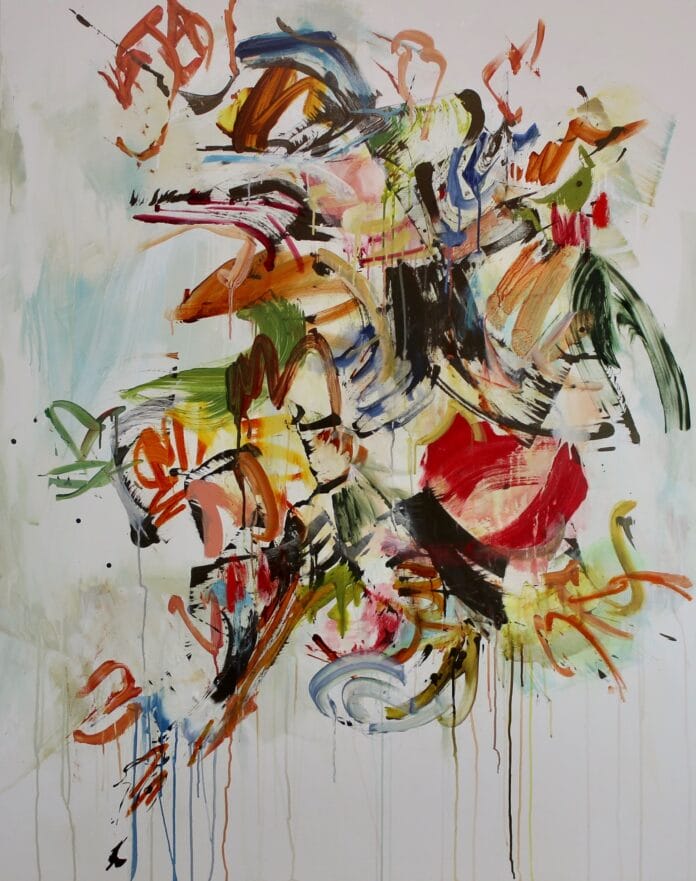Nikki Hill-Smith is an abstract painter whose work is a vibrant dialogue between chaos and control, chance and intention. In a single glance, her art can transport the viewer from the window seat of an airplane soaring over opalescent seas to the magnified mysteries beneath a microscope. Her canvases pulse with energy, with squiggles and smears, dribbles and daubs, that dissolve the boundaries between the macro and micro worlds.
Hill-Smith’s paintings defy the simple act of looking; they demand immersion. They invite the viewer to lose their bearings, to surrender to the delicious disorientation that comes from perceiving both vastness and intimacy at once. In her work, the dynamics of scale, composition, and even time itself become fluid. Time, that ever-vanishing force, seems to pause and pool in her layered fields of paint, as if each gesture has captured a fleeting moment of reflection suspended in slow motion.
Between Abstraction and Emotion
To encounter a Hill-Smith painting is to step into a dream, familiar yet fractured, serene yet alive with restless thought. Her approach to abstraction transcends mere form; it becomes a meditation on perception itself. The brushstrokes are not simply marks, but questions on how we conceive, perceive, and experience the world.
Her work operates on multiple levels. It delights the senses while engaging the intellect. There is a palpable joy in her painterly fizz, yet beneath that surface energy lies a quiet inquiry into the act of painting as both revelation and resistance. Viewers are not merely observers but participants in this visual conversation, held captive by the hypotheses her paintings propose—questions about meaning, memory, and the language of image-making itself.
Infinitely Interruptible
At the heart of Hill-Smith’s practice lies her ongoing series, Infinitely Interruptible, a body of work that redefines spatial perception. Each canvas begins as an interrogation of space, flattened yet alive, negating and affirming itself all at once. Through her kaleidoscope of colour and motion, she creates a pictorial field in constant flux, one that vibrates between form and formlessness.
Just as Wassily Kandinsky once liberated space from the literal and the linear, Hill-Smith continues that lineage, offering space not as a container but as an experience. Her paintings possess no horizon, no single perspective, no fixed point. They stretch the continuum of time and place until both dissolve into pure sensation.
In this state of suspension, painting itself becomes the subject. The surface does not present a stable ground but a turbulence, a site of push and pull where the artist wrestles with her medium. Each mark becomes an act of negotiation between freedom and restraint, between the known and the unknowable. Space is not a stage for performance but an ever-shifting current in which Hill-Smith’s gestures move, collide, and reconfigure.
The Conversation of Painting
For Hill-Smith, painting begins where words fail. Each canvas becomes a field of rhythm, argument, and chance, a space where colour thinks for itself. She works between connection and separation, allowing gestures to collide and fragments to find their own unfinished harmonies.
This philosophy reveals painting as an act of listening as much as of making. It is not about control but about conversation, a dialogue between colour, gesture, history, and the raw material of being. Her studio practice embraces uncertainty and imperfection, celebrating the moments when paint resists or surprises.
She believes you have to love the stuff, the mess, the weight, the way paint resists and gives in all at once. In an era dominated by flawless digital images, Hill-Smith is drawn to what falters, to the drag of the brush and the hesitation that becomes rhythm. Her art reminds us that beauty often lives in what wavers, not in what is perfected.
Ghosts of the Past, Breath of the Present
Hovering at the edges of her compositions are what Hill-Smith calls the ghosts of painters before me, echoes of those who have grappled with similar questions of form and meaning. Yet these presences do not haunt her canvases as burdens but as companions, reminding her that painting never dies; it simply finds new ways to breathe.
Through this lineage, her work becomes a continuation of painting’s eternal dialogue, a living language that evolves through each generation. Her process, though deeply personal, feels part of something larger: the timeless pursuit of making sense of experience through colour, rhythm, and the physical act of mark-making.
Sequential Snowdrops
Among her recent works, Sequential Snowdrops stands as a striking embodiment of her artistic ethos. Executed in mixed media, it encapsulates her fascination with rhythm, contrast, and the liminal tension between movement and stillness.
The composition reveals an interplay between fragility and persistence, the snowdrop as both fleeting bloom and enduring symbol. Through layered gestures and tonal shifts, Hill-Smith transforms the ephemeral into the eternal, inviting the viewer into a world that is at once delicate and forceful.
In this piece, as in much of her oeuvre, abstraction becomes a mirror of life’s continuity, sequential moments unfolding in quiet succession, each carrying its own resonance yet bound by the pulse of existence.
Painting as Existence
Nikki Hill-Smith’s art is more than an exploration of form or colour; it is a meditation on being. Her canvases embody the paradoxes of existence, movement within stillness, order within chaos, light within shadow. They remind us that painting is not an escape from the world but an immersion in it, an act of seeing and feeling that words alone cannot convey.
Through her work, Hill-Smith reaffirms that painting remains infinitely interruptible, never finished, always in flux, forever breathing.


